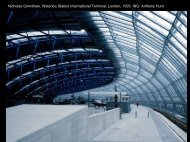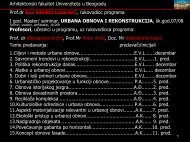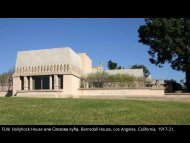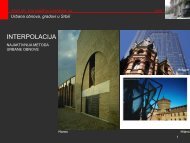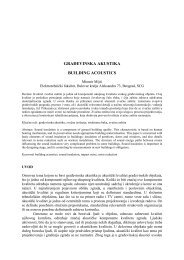Architecture and Ideology
Architecture and Ideology
Architecture and Ideology
You also want an ePaper? Increase the reach of your titles
YUMPU automatically turns print PDFs into web optimized ePapers that Google loves.
Dr RADIVOJE DINULOVIĆ, Professor<br />
Faculty of Technical Sciences, University of Novi Sad, radivoje.dinulovic@gmail.com<br />
THE IDEOLOGICAL FUNCTION OF ARCHITECTURE IN THE<br />
SOCIETY OF SPECTACLE<br />
Abstract |<br />
Economical, political, social <strong>and</strong> cultural context we live in has already been defined in 1960’s<br />
as a Society of spectacle (Debord). This society is based on radical exploitation of recourses –<br />
technology <strong>and</strong> media, above all. At the same time, it has lost an ideological background – in<br />
theological, philosophical or even ethical sense. Everything that has, from the Marxist point of<br />
view, been considered as “social superstructure” becomes an independent value, mainly<br />
commercial in nature. In such a world, role of architecture – as an artistic, social <strong>and</strong> existential<br />
category – has been changed. Traditional underst<strong>and</strong>ing <strong>and</strong> definition of architecture (utilitas<br />
– firmitas – venustas) is not satisfactory any more. The form – built, modelled or thought – is<br />
always an outcome of architecture since the only issue we can consider, in fact, is an<br />
architectural form. At the same time, contemporary architecture is not only based on using a<br />
full variety of media sources, technologies <strong>and</strong> their development, but new engineering<br />
solutions, materials <strong>and</strong> building techniques become a generator of thinking about physical<br />
structure <strong>and</strong> space in general. In that context, function of instead of function in architecture<br />
needs to be observed as a dominant value. Furthermore, the word ‘function’ should be<br />
understood as pluralia tantum, or even material noun. As photography does not reach art<br />
through painting but through theatre (Barthes), architecture reaches art through its functions<br />
<strong>and</strong> not through visuality. This is why function of architecture is not only utilitarian (having in<br />
mind the fact that without utility there is no architecture), but is a complex system of answers<br />
about different existential needs – economical <strong>and</strong> ecological, aesthetical, social, cultural,<br />
psychological, philosophical, ethical, political etc. <strong>Architecture</strong> as a system of thinking about<br />
space, establishes relation towards all of these problem aspects simultaneously <strong>and</strong> becomes<br />
an ideological category per se. Since human life represents a basic <strong>and</strong> essential object of<br />
architecture (Milićević), structure <strong>and</strong> final form of architecture need to be concerned as a<br />
machine (Le Corbusier), not as a scene, sculpture or designed artefact.<br />
Key words |<br />
Modernism, Judaism, Einstein, space‐time, Post‐Modernism, Deconstruction<br />
39




